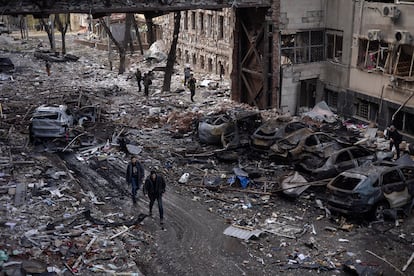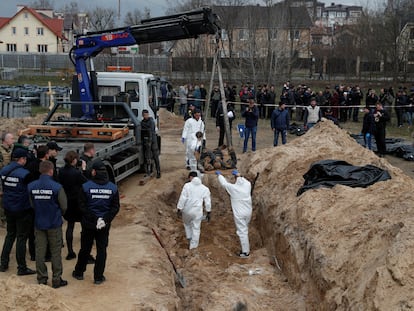Life in Kharkiv’s underground bomb shelters: ‘It’s our city, it’s our home’
In the second-largest city in Ukraine, people take refuge in basements and subway stations, as they put into practice the survival skills they have learned since the start of the Russian invasion


In a shelter on Moscow Avenue in Kharkiv, Ukraine’s second-largest city after the capital Kyiv, Vadym Stoyank and his friends are drinking. “It’s the best way to forget the sound of the bombs,” he says. Ukrainian artillery and Russian missiles can be heard every hour. Once curfew starts at 8pm, the invader’s military might is unleashed with blood-curdling explosions that only alcohol, says Stoyank, can help them bear.
Stoyank and the 20 other people who are living in the shelter on Moscow Avenue did not know each other before the war. They were neighbors in the hive-like apartments of Soviet housing. Perhaps they greeted each other on the stairs, or walking the dog, but they knew little else about one another. Until the Russians invaded, that is. Now they live together every night in the damp cellars of the building, sleeping on cots and preparing dinner on two folding tables. At first there were 150 people, now there are only two dozen. Most have fled the city, abroad or to the west of the country.
The Russian siege of Kharkiv began on the first day of the invasion, February 24. The streets are filled with shattered buildings, facades falling off in pieces, and the sidewalks are covered with broken glass. Alcohol and tobacco kiosks have been looted and the people have fled to double-locked shelters because they fear being robbed. The Russians are close, surrounding the northern districts, the closest to Russia, but Ukraine’s artillery, anti-aircraft defenses and imposing military presence have stopped them from advancing further.
Stoyank and his friends – Eugenia, Andrei, Iilya, Denis and Borys – have learned together how to survive in a war. In Kharkiv, it is easy to put into practice the lessons that have been learned since the beginning of the Russian invasion. One important lesson is that when you hear the whistle of a missile it means that it will be close; it will hit in no more than five seconds. Those five seconds are essential: it is the time needed to take cover on the ground and increase your chances of getting out alive.

There are two neighborhoods in Kharkiv that are considered off-limits: Saltivka and Piatykhatky. Taisia Kupchina, 74, who is all alone in the world, lives in Saltivka – quite a feat considering that even the Ukrainian soldiers who control access to the neighborhood fear the place.
If 30% of Kharkiv’s population – out of a total of 1.4 million inhabitants – remains in the city, in Saltivka, no more than 10% have stayed. Shells hit this area so often, several times an hour, that it’s impossible to imagine how anyone could stay alive there. But there they are, underground, elderly people, people with reduced mobility and the poor. They are men and women like Kupchina who pulls a cart with five jugs of water to be filled at a public fountain. Half of her building has been destroyed, essential supplies are no longer working. She lives crowded in the basement of the building with five other neighbors. One of them is Gvardicev Shironitsev, a former real estate agent who lost his apartment and who has also lost his mind, according to one of his neighbors. Shironitsev spends his time obsessively looking at photos he keeps on his phone of his pre-invasion existence. In the images, he looks like a cheerful, stocky and elegant man; now he is a bag of bones, with waxy skin, dressed in the only change of clothing he has: a dirty tracksuit and sneakers.
In the Saltivka neighborhood, they know the basic rules of survival by heart. Around the corner of Kupchina’s block, smoke rises from three small establishments, which have been struck by three missiles fired from a BM-21 multiple rocket launcher just a few minutes ago. Kupchina cries silently and asks for a hug. Every morning she puts on lipstick on and applies rouge to her cheeks because, as she repeats, she wants to carry on with life. Experience suggests that this position will not be attacked again for a long time. But there is no knowing what can happen a few meters ahead.
Outside school 134 in Kharkiv, there are shell casings and grenade rings everywhere. The Russian infantry took cover there in the second week of the war, until they were pushed out. Near Shevchenko Street, where the school is located, the remains of a missile intercepted by anti-aircraft shields fell on Viktor’s garage on Thursday. This 28-year-old professional dancer was going to his neighborhood, Shyshkivka, near the front, but he turned back because he heard shells fired from tanks and even the firing of rifles.
Another lesson that is learned under siege, summarizes Denis Onipko, a friend of Viktor, is to recognize weapons by the sound they emit: “The ones that sound with an echo are ours,” says the 29-year-old cabinetmaker, who is now working as a volunteer handing out food. “I have been hearing sounds that I didn’t recognize for a few days,” adds Onipko with a triumphant tone. “They are the weapons that have come from Europe.”
In the Kominternovski district of Kharkiv, people are waiting to receive food from a charity. Some 5,000 people line up every day to receive a meal. This Saturday it was chicken thighs. They will then go to another point close by where they can pick up clothes. Those waiting in line are weary of the journalists: they do not want the location of the donation spots to be identified; they are afraid of becoming the target of Russia’s campaign of terror.
Irina Malikeva lives in constant fear. She lives in a neighborhood in the south of the city that was attacked by Russian missiles on Friday morning. The strike destroyed the homes of two of her neighbors. Malikeva is 60 years old and doesn’t want to leave her home, which her father built 45 years ago. “I don’t have enough money to live in Europe and I don’t know what I could do there, but if I stay here,” Malikeva continues, “I can die.”
There are other survivors in Kharkiv who could leave the city, but prefer not to. The Shevsuk family has been living on a subway station platform for six weeks. Their house in Saltivka no longer exists. Aksana, a mother of a three-year-old boy, believes that nowhere in Ukraine is safe and says that they don’t want to live as refugees in a sports hall in some unknown part of Europe. “It’s our city, it’s our home.”
The sun sets again and in the shelter on Moscow Avenue, Stoyank and his friends are stocking up with more bottles of alcohol and food. Daria Gierovsk’s giant teddy bear will be used as a pillow. Her apartment was destroyed two weeks earlier and she has been given a space in Stoyank’s basement. In the morning, when she finally steps outside to get some fresh air, Gierovsk’s hands are still shaking, the result of panic attacks caused by the sound of explosions during the night. Despite this, she says, she is from Kharkiv and does not plan to leave her city.
Tu suscripción se está usando en otro dispositivo
¿Quieres añadir otro usuario a tu suscripción?
Si continúas leyendo en este dispositivo, no se podrá leer en el otro.
FlechaTu suscripción se está usando en otro dispositivo y solo puedes acceder a EL PAÍS desde un dispositivo a la vez.
Si quieres compartir tu cuenta, cambia tu suscripción a la modalidad Premium, así podrás añadir otro usuario. Cada uno accederá con su propia cuenta de email, lo que os permitirá personalizar vuestra experiencia en EL PAÍS.
¿Tienes una suscripción de empresa? Accede aquí para contratar más cuentas.
En el caso de no saber quién está usando tu cuenta, te recomendamos cambiar tu contraseña aquí.
Si decides continuar compartiendo tu cuenta, este mensaje se mostrará en tu dispositivo y en el de la otra persona que está usando tu cuenta de forma indefinida, afectando a tu experiencia de lectura. Puedes consultar aquí los términos y condiciones de la suscripción digital.
More information
Últimas noticias
Most viewed
- Sinaloa Cartel war is taking its toll on Los Chapitos
- Oona Chaplin: ‘I told James Cameron that I was living in a treehouse and starting a permaculture project with a friend’
- Reinhard Genzel, Nobel laureate in physics: ‘One-minute videos will never give you the truth’
- Why the price of coffee has skyrocketed: from Brazilian plantations to specialty coffee houses
- Silver prices are going crazy: This is what’s fueling the rally










































